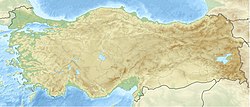| UTC time | 1983-10-30 04:12:30 |
|---|---|
| ISC event | 567451 |
| USGS-ANSS | ComCat |
| Local date | 30 October 1983 |
| Local time | 07:12:30 |
| Magnitude | 6.6 Mw |
| Depth | 15 km |
| Epicenter | 40°21′00″N42°11′16″E / 40.35°N 42.1879°E |
| Type | Oblique-slip |
| Areas affected | Turkey |
| Max. intensity | MMI IX (Violent) [1] |
| Landslides | Yes |
| Casualties | 1,342 dead |
The 1983 Erzurum earthquake occurred in northeastern Turkey on 30 October 1983 at 07:12 local time (04:12 UTC). [2] It had a moment magnitude of 6.6 and a maximum Mercalli intensity of IX (Violent). Reuters reports that about 1,340 people have died and 50 settlements in the provinces of Erzurum and Kars have been demolished by the earthquake. [3]
